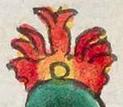tlachinolli (Mdz15v)
This element for a conflagration or something burning (tlachinolli) has been carved from the compound sign for the place name, Tlachinolticpac. In the original compound, the flames appear on top of a hill or mountain (the green part that remains below it actually belongs to the hill). The flames have a graduated color, from red on the outside to orange and finally yellow in the middle. Also in the middle is a small circle. The colors tie in with the colors of flames. The shape of the flames are something like wings, and yet they are multiple.
Stephanie Wood
This hieroglyph, which has been used in the original place name for the word tlachinolli, is strikingly similar to the heart of the fire (tletl) that appears in the Magliabechi Codex on folio 71r (see below).
The flames may conjure up red bird wings. Brilliant feathers were compared to flames in the Florentine Codex, as Allison Caplan points out (2020, 390). The significance of the small circle is less obvious, although it my hint at the sun (and its warmth) as being akin to fire. The fire-bird or butterfly likeness might not be coincidental. In our Online Nahuatl Dictionary we see an attestation to the word tlachinolli being likened to a cardinal or scarlet macaw (cuezalin), and cuezalin feathers appear much like flames in various glyphs in the Codex Mendoza. Furthermore, the wings of a butterfly can flicker like flames of a fire, and so butterflies have an association with fire. [See: Markman and Markman, Masks of the Spirit, 1989, 148.] See also the glyphs, below, for the name Tlepapalotl (flame-butterfly).
Tlachinolli is part of the diphrasis, in atl (or in teoatl), in tlachinolli (divine flood and scorched earth or burned land, i.e., either disasters or "sacred warfare," according to Janice Lynn Robertson, 2017, 189). Katarzyna Mikulska (2020, 52-54) discusses the possibility for diphrasis and metonymic series (after Dehouve) to be "represented graphically." She gives various examples of the atl-tlachinolli diphrase. See also Mercedes Montes de Oca Vega's discussion of couplets in Nahuatl (with iconographic expressions) in Mexicolore.
Stephanie Wood
c. 1541, but by 1553 at the latest
Stephanie Wood, Xitlali Torres
flames, flamas, fires, fuegos, tierras quemadas, conflagration

tlachinol(li), something burning, a conflagration, https://nahuatl.wired-humanities.org/content/tlachinolli
tle(tl), fire, https://nahuatl.wired-humanities.org/content/tletl
tlatla, to burn, https://nahuatl.wired-humanities.org/content/tlatla
James Lockhart (The Nahuas, 1992, 120) refers to the name Yaotlachinol, witnessed in a census from the Cuernavaca region (1535–45), calling it as "The Scorching of War."
Stephanie Wood
Codex Mendoza, folio 15 verso, https://digital.bodleian.ox.ac.uk/objects/2fea788e-2aa2-4f08-b6d9-648c00..., image 41 of 188.
The Bodleian Libraries, University of Oxford, hold the original manuscript, the MS. Arch. Selden. A. 1. This image is published here under the UK Creative Commons, “Attribution-NonCommercial-ShareAlike 3.0 License” (CC-BY-NC-SA 3.0).

